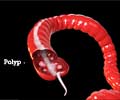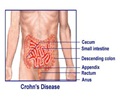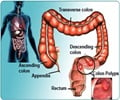When endoscopists work on shorter day shifts it seems to reflect in better polyp detection rate, a recent research has shown.
Data from 3,846 colonoscopies performed at Mayo Clinic during 2008 were examined in the study. After excluding factors known to influence polyp detection, such as poor bowel preparation and involvement of fellows in training in the procedures, researchers compared polyp detection rates by daily shifts."Some people develop colon cancer even after having colonoscopies," says Gregory Munson, M.D., M.P.H., a gastroenterology fellow at Mayo Clinic and study co-author. "Polyp miss rates are partially to blame, so we want to discover how to make the quality of the colonoscopy exam better.
"It's known already that longer colon exam times during endoscope withdrawal increase polyp detection rates. Our data show that each additional minute spent on withdrawal predicts a 4 percent increase in the polyp detection rate. This has led some health care facilities to require a minimum withdrawal time. We were curious whether shorter shifts positively influence polyp detection rates."
Mayo Clinic schedules outpatient colonoscopies during three 3 hour shifts each weekday (a morning shift, 7:30 to 10:30 a.m.; a midday shift, 10:30 a.m. to 1:30 p.m.; and an afternoon shift, 1:30 to 4:30 p.m.). Researchers found the morning shift polyp detection rate was 39.1 percent, midday was 44.6 percent and afternoon was 38.9 percent. The average time a colon was examined during scope withdrawal remained constant throughout the day at just over eight minutes, with only a five-second variation between the shifts with the longest and shortest average times, Dr. Munson says.
According to Dawn Francis, M.D., M.H.S., (http://www.mayoclinic.org/bio/13311140.html) a gastroenterologist at Mayo Clinic and lead researcher, these findings differ from similar studies done at other health care facilities that employ traditional half-day shifts. The decrease in polyp detection rates later in the day in those studies is attributed to endoscopist fatigue.
"Our endoscopists usually work only one three-hour shift per day rather than a half or full day of endoscopy," Dr. Francis says. "With shorter shifts throughout the day, we don't see the drop in polyp detection rate later in the day that has previously been reported. Other health care facilities might also want to consider a model that breaks up the day into three-hour shifts."
Advertisement
"It's hard to tell from the data," Dr. Munson says. "Despite our attempt to control for patient and endoscopist variables, it could be that patients who show up at midday have more polyps or that endoscopists are better at detecting polyps during midday. We need to do more analysis to pinpoint the factors that make a difference."
Advertisement
Source-Eurekalert
SAV














